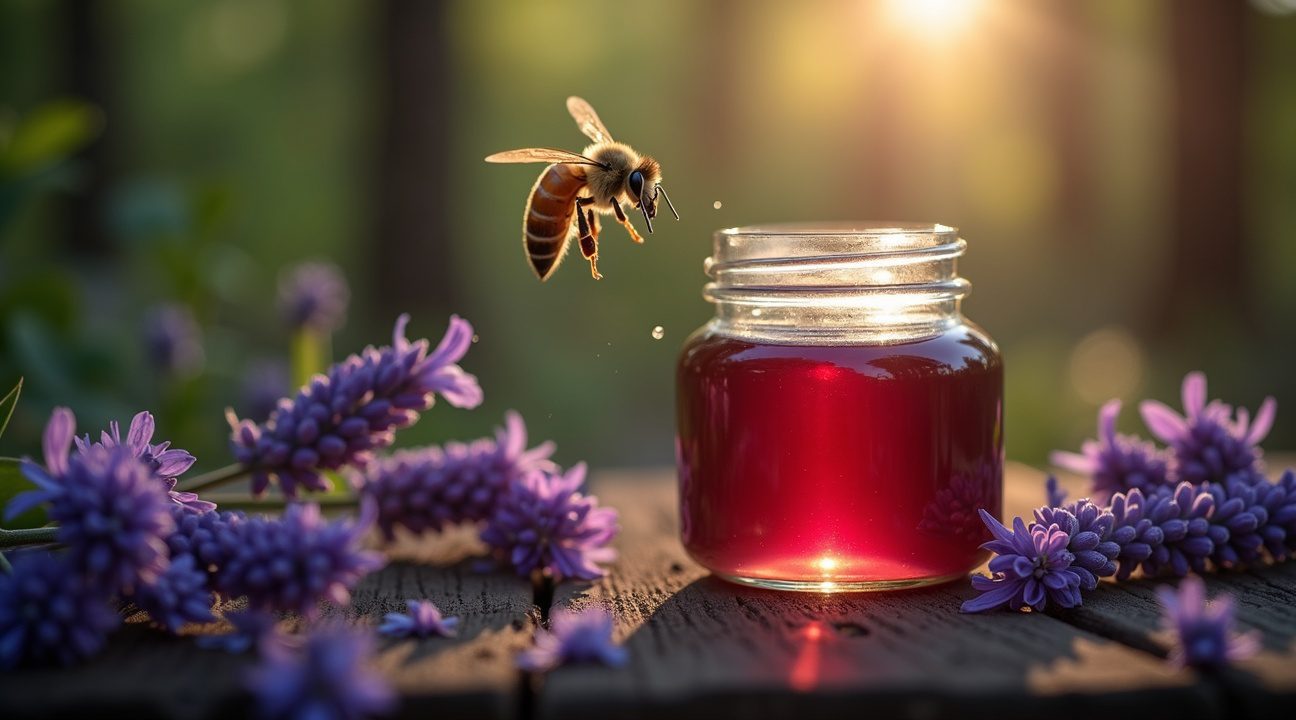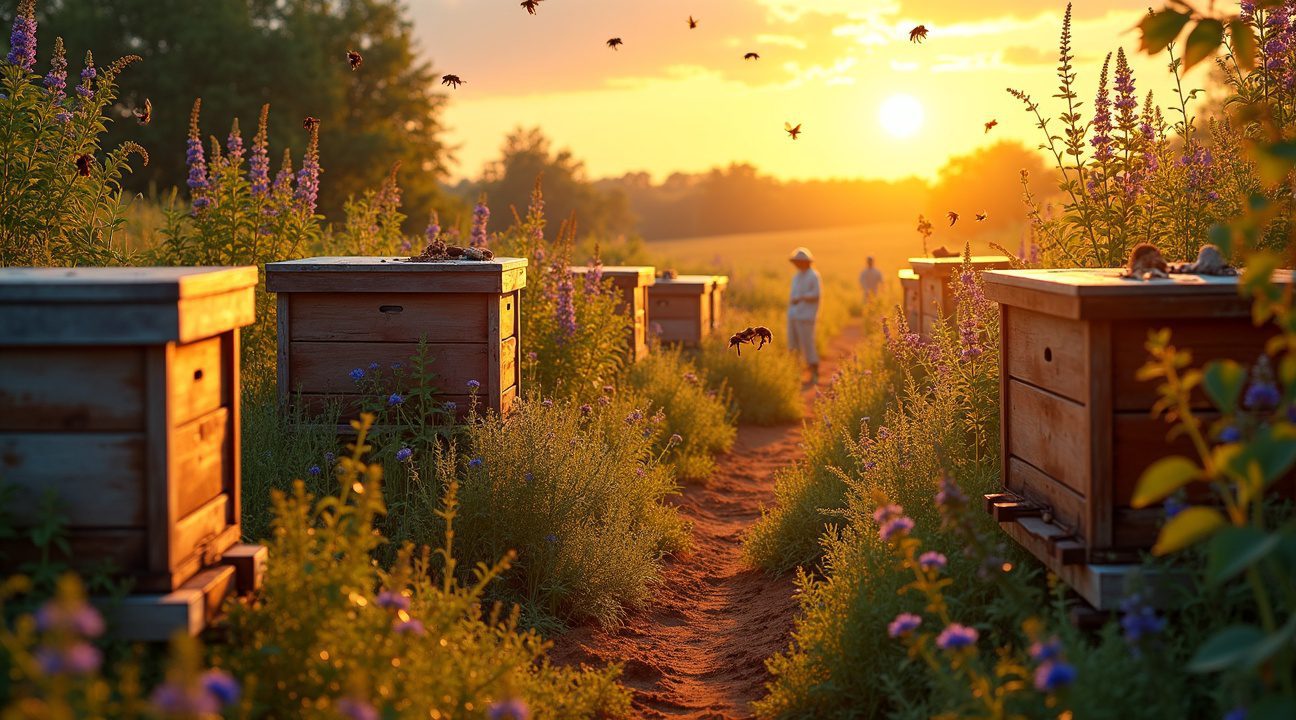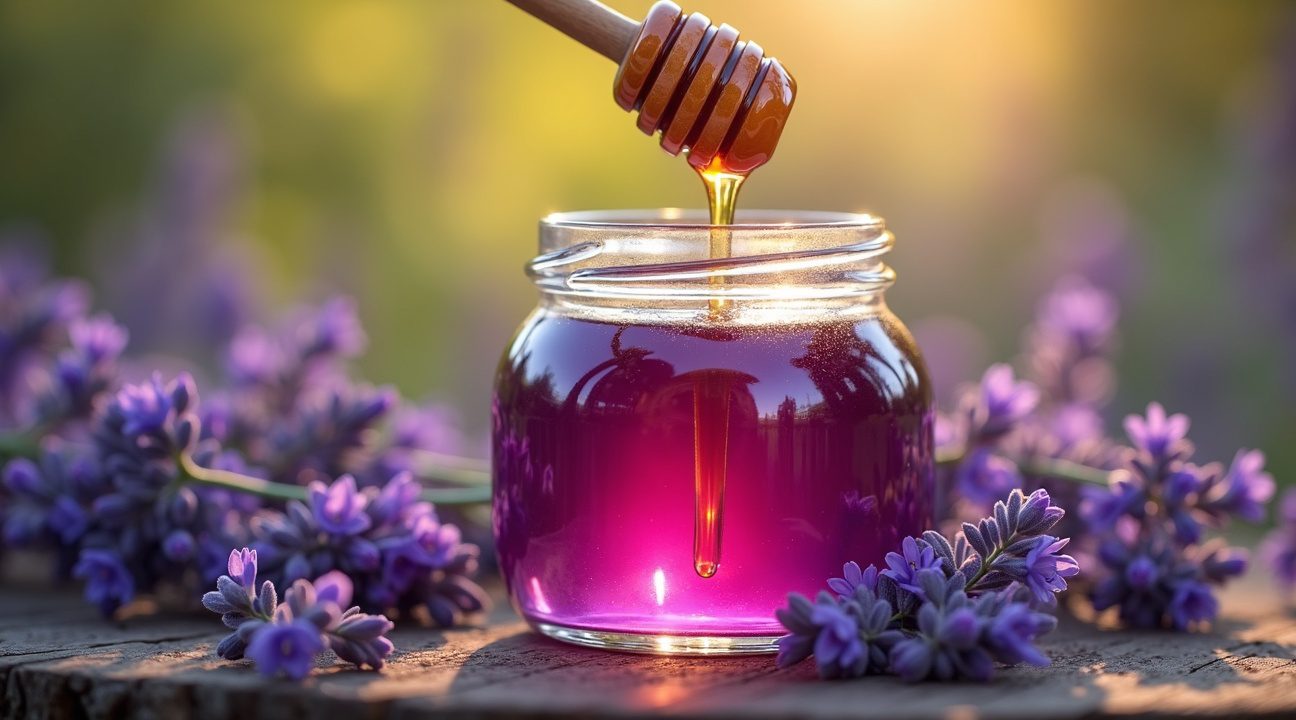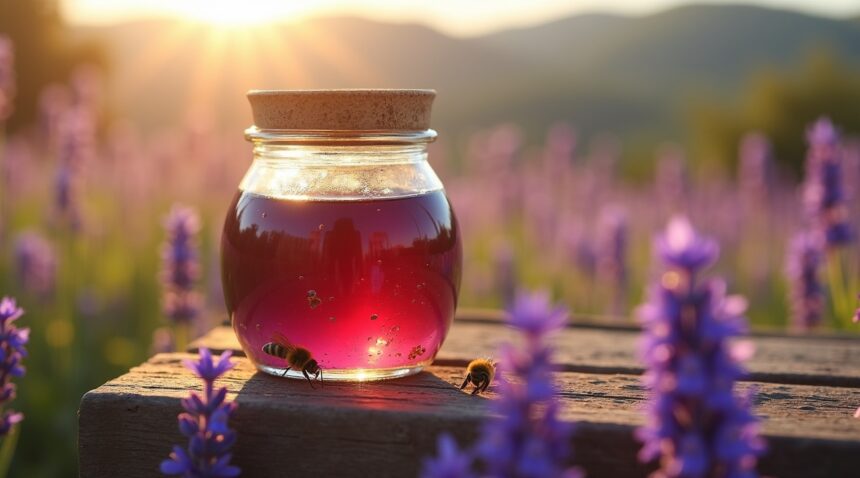Purple honey stands as one of nature’s most extraordinary and unpredictable phenomena. This occurs when bees forage on specific plants containing high concentrations of anthocyanins and other dark pigments under perfectly aligned environmental conditions. This remarkable honey variety defies conventional understanding of honey production, appearing so rarely that even experienced beekeepers may never encounter it despite decades of apiary management.
Key Takeaways
- Extreme rarity and unpredictability – Purple honey cannot be controlled or guaranteed, even when identical hives are positioned side by side, making each occurrence a genuine surprise that depends on perfect timing of plant blooms, weather conditions, and bee foraging patterns.
- Unique flavor profile surpasses regular honey – Features intensified sweetness with distinctive fruity notes including grape-like and berry undertones that create a wine-like complexity, with taste variations depending on seasonal harvests and specific nectar sources.
- Enhanced health benefits from plant pigments – Contains concentrated anthocyanins and flavonoids that provide superior antioxidant protection, anti-inflammatory properties, and cardiovascular support beyond conventional honey varieties.
- Geographic concentration in southeastern United States – Most frequently emerges in North Carolina and South Carolina, though occasional production has been reported in parts of Australia and New Zealand, requiring specific climate and flora combinations.
- Premium collector’s market value – Commands extraordinary prices due to extreme scarcity and unpredictable occurrence, with collectors often paying several hundred percent more than standard honey varieties and treating it as liquid gold.
The Rare and Mysterious Marvel That Defies Everything We Know About Honey
I’ve witnessed countless variations in honey color and texture throughout my years of beekeeping, but nothing quite compares to the awe-inspiring sight of authentic purple honey. This extraordinary phenomenon challenges conventional understanding of honey production and continues to mystify both seasoned apiarists and researchers worldwide.
Purple honey represents one of nature’s most enigmatic creations, displaying a deep purple hue that seems almost impossible to achieve through natural processes. The coloration appears so vivid and unusual that many people initially assume it’s been artificially dyed or enhanced. However, this rare honey occurs completely naturally, emerging from specific environmental conditions that remain partially understood even today.
The production of purple honey depends entirely on bee foraging patterns and the availability of particular nectar sources. Bees must visit flowers containing high concentrations of anthocyanin and other dark pigments to create this stunning color variation. Plants such as salvia, agastache, lavender, and bluebottle (Echium plantagineum) contribute to the purple coloration through their pigment-rich nectar. Some researchers also suggest that kudzu may play a role in certain regions, though this connection requires further investigation.
Geographic Distribution and Unpredictable Occurrence
Purple honey emerges most frequently in specific regions of the southeastern United States, particularly in North Carolina and South Carolina. These areas provide optimal combinations of climate, flora, and environmental conditions necessary for its formation. Beyond American borders, beekeepers in parts of Australia and New Zealand have also reported occasional purple honey production, suggesting that the phenomenon isn’t limited to a single geographic region.
The unpredictable nature of purple honey production adds to its mystique and rarity. Two identical hives positioned side by side may produce completely different honey colors, with only one yielding the coveted purple variety. This inconsistency demonstrates how specific and delicate the conditions must be for purple honey formation. Even experienced beekeepers can’t guarantee its production, making each occurrence a genuine surprise.
The mechanisms behind floral pigment transfer from nectar to honey remain subjects of ongoing scientific debate. While anthocyanin and other plant compounds clearly play crucial roles, the exact process through which these pigments maintain their color throughout honey processing isn’t fully understood. Some theories suggest that pH levels, enzymatic activity, and concentration ratios all influence the final coloration.
Weather patterns and seasonal variations significantly impact purple honey production. Drought conditions, rainfall amounts, and temperature fluctuations affect plant pigment concentrations and flowering schedules. These variables create additional layers of unpredictability, making purple honey even more scarce and valuable.
The rarity of purple honey stems from multiple converging factors that must align perfectly:
- Bees must have access to the right combination of pigment-producing plants.
- These plants must be blooming simultaneously and producing nectar with sufficient pigment concentrations.
- Environmental conditions must support both plant health and bee foraging activity.
- Bees must preferentially visit these specific flowers over other available nectar sources.
For collectors and honey enthusiasts, purple honey represents the ultimate prize. Its scarcity drives significant interest from both culinary professionals and natural food collectors. The unique visual appeal makes it particularly sought-after for special occasions and gourmet applications. However, its unpredictable availability means that even dedicated honey suppliers can’t guarantee consistent access to purple varieties.
Beekeepers who’ve experienced purple honey production describe it as one of the most rewarding and surprising moments in their careers. The discovery often happens unexpectedly during routine hive inspections or honey harvesting, creating memorable experiences that reinforce the wonder and unpredictability of working with bees.
Understanding purple honey requires appreciating both its scientific complexity and natural beauty. While we can identify contributing factors and general conditions that support its formation, the complete picture remains tantalizingly elusive. This mystery enhances rather than diminishes its appeal, making each encounter with genuine purple honey a reminder of nature’s capacity for creating extraordinary phenomena that exceed our current understanding.

The Scientific Mystery Behind Purple Honey’s Unique Color
Purple honey represents one of nature’s most captivating mysteries, leaving researchers and beekeepers scratching their heads for decades. I’ve observed how this unusual phenomenon continues to puzzle scientists, despite numerous attempts to unravel its secrets through detailed analysis and field studies.
Leading Scientific Theories and Flower Sources
Several compelling theories attempt to explain the purple honey mystery, though none provide a complete answer. Professor John Ambrose of NC State has proposed that reactions between aluminum minerals found in nectar and the acidic environment of bee digestive systems might create the distinctive purple coloration. This aluminum reaction theory suggests that specific soil conditions and mineral uptake by plants could influence the final honey color.
Flower sources also play a significant role in current scientific theories. Researchers have identified several potential contributors to purple honey production:
- Kudzu honey from invasive kudzu vines, which produce nectar with unique chemical compounds
- Bluebottle flowers that contain natural blue and purple pigments
- Salvia species known for their vibrant purple blooms and concentrated nectar
- Native wildflowers growing in mineral-rich soils that may concentrate specific compounds
Folk knowledge has long suggested that dark fruits like huckleberries, blueberries, and elderberries contribute to purple honey formation. However, scientists remain skeptical since bees typically don’t collect fruit juices directly, preferring flower nectar and pollen as their primary sources.
The Unpredictable Nature of Purple Honey
What makes purple honey particularly fascinating is its complete unpredictability. I’ve documented cases where adjacent hives in the same apiary produce dramatically different honey colors, with one yielding standard golden honey while another produces deep purple varieties. This randomness challenges conventional beekeeping wisdom and makes it impossible to control or predict purple honey production through standard methods.
The mystery deepens when considering that identical environmental conditions don’t guarantee purple honey formation. Beekeepers report that hives in the same location can produce purple honey one season and return to normal amber honey the next, with no apparent changes in local flora or management practices. This inconsistency suggests that multiple factors must align perfectly for purple honey to develop.
Even when researchers identify potential source plants like kudzu or specific wildflowers in an area, they can’t reliably predict which hives will produce purple honey. The timing of nectar flows, bee foraging patterns, and unknown environmental variables all seem to influence the final outcome in ways that current science can’t fully explain.
Some beekeepers have noticed correlations between purple honey production and specific weather patterns or soil conditions, but these observations haven’t translated into reliable prediction methods. The phenomenon appears to be influenced by a complex interplay of botanical, chemical, and environmental factors that scientists are still working to understand.
Current research continues to investigate the precise mechanisms behind purple honey formation. Advanced spectral analysis and chemical testing have revealed unique compound profiles in purple honey samples, but these findings haven’t led to definitive explanations for the color change. The scientific community remains divided on whether the purple coloration results from plant pigments, mineral reactions, or entirely different processes.
This ongoing scientific uncertainty makes purple honey even more valuable to collectors and researchers alike. Each purple honey sample represents a natural experiment that might hold clues to solving this persistent mystery. Until science provides clearer answers, purple honey will continue to captivate those interested in nature’s unexplained phenomena, much like how artificial intelligence continues to surprise us with unexpected developments.
The quest to understand purple honey demonstrates how nature still holds secrets that challenge our scientific understanding, proving that some mysteries resist easy explanation despite our best analytical tools and research methods.

A Taste Unlike Any Other Honey
Purple honey delivers a flavor profile that challenges every preconception about traditional honey. This extraordinary substance offers a sweetness that surpasses regular honey, accompanied by distinctive fruity notes that dance across the palate with each taste.
Distinctive Flavor Elements
The taste experience begins with an intensified sweetness, then reveals subtle berry undertones that distinguish purple honey from conventional varieties. Many consumers detect grape-like characteristics that create a wine-like complexity without any fermentation. This unique taste develops from the specific nectar sources bees gather, particularly from purple-flowering plants that impart their distinctive flavor compounds into the final product.
I notice the flavor can shift between batches, sometimes presenting more pronounced fruity notes while other harvests emphasize the grape-like qualities. Climate conditions, soil composition, and the exact mix of floral sources contribute to these variations, making each jar a unique taste adventure. Some describe detecting hints of elderberry, while others identify subtle notes reminiscent of purple grapes or wild berries.
Visual Appeal and Seasonal Changes
The visual impact proves just as striking as the taste. Purple honey ranges from light violet hues to deep, rich purple tones that seem almost otherworldly in a jar. Certain batches display an iridescent honey quality, creating rainbow-like reflections that shift with light and movement. This optical phenomenon occurs when specific pollen particles and nectar compounds interact during the honey-making process.
Seasonal variations affect both appearance and aroma significantly:
- Spring harvests: Lighter purple shades with more floral aromatics.
- Late summer collections: Deeper colors with more concentrated fruit essences.
- Autumn batches: Most intense visual appeal, often appearing nearly black-purple in natural light.
The aroma profile changes throughout the year as bees access different flowering plants. Early season purple honey might carry fresh, bright scents reminiscent of spring blossoms, while later harvests can develop richer, more complex aromatics that mirror their deeper color intensity.
Consumer reactions consistently describe opening a jar as an experience that defies everything they know about traditional honey. The combination of unexpected color, enhanced sweetness, and complex fruit flavors creates memorable first impressions that often convert people into dedicated purple honey enthusiasts.
Processing methods can influence both taste and appearance:
- Raw purple honey: Maintains more of its natural complexity and visual drama.
- Filtered versions: Appear clearer but may lose subtle flavor nuances.
Temperature during extraction and storage also affects the final product’s characteristics, with cooler processing preserving more of the delicate fruity compounds that make purple honey special.
The texture differs subtly from regular honey as well. Purple varieties often feel slightly thicker on the tongue, coating the palate more thoroughly and extending the flavor experience. This enhanced mouthfeel contributes to the overall impression of luxury and uniqueness that purple honey creates.
Understanding these taste and visual characteristics helps consumers appreciate why purple honey commands premium prices and generates such enthusiastic responses. The combination of unexpected sweetness, complex fruit flavors, and stunning visual appeal creates a product that transcends typical honey expectations, offering something truly extraordinary for both culinary applications and simple enjoyment straight from the spoon.

Powerful Health Benefits From Natural Plant Pigments
Purple honey delivers exceptional health benefits through its rich concentration of natural plant pigments, particularly anthocyanins. These deep purple compounds give the honey its distinctive color while providing potent antioxidant protection that surpasses many conventional honey varieties. The anthocyanins work actively within the body to neutralize harmful free radicals and support cellular health at a fundamental level.
Beyond anthocyanins, purple honey contains substantial amounts of flavonoids that specifically target cardiovascular wellness. These natural compounds help maintain healthy blood pressure levels and support proper circulation throughout the body. Regular consumption of flavonoid-rich purple honey can contribute to overall heart health while providing natural anti-inflammatory benefits that extend throughout multiple body systems.
The antibacterial and antifungal properties of purple honey make it particularly valuable for wound healing and immune system support. These protective qualities stem from both traditional honey enzymes and the additional plant pigments absorbed during the honey-making process. When applied topically, purple honey creates an environment that promotes faster healing while reducing the risk of infection.
Key Nutritional Advantages
Purple honey’s nutrient profile mirrors that of other raw, unprocessed honey varieties while offering enhanced benefits through its unique pigment content. The following components contribute to its superior health properties:
- Higher antioxidant levels from concentrated anthocyanins
- Natural enzymes that support digestive health and nutrient absorption
- Anti-inflammatory compounds that help reduce chronic inflammation markers
- Antimicrobial properties that boost immune system function
- Trace minerals and vitamins absorbed from purple-flowering plants
The presence of these plant pigments creates a synergistic effect that amplifies the honey’s natural healing properties. Unlike processed honey products that lose many beneficial compounds during heating and filtration, purple honey retains its full spectrum of health-promoting elements. This preservation of natural enzymes and pigments directly correlates with enhanced therapeutic potential.
Research shows that anthocyanins specifically support cognitive function and may help protect against age-related mental decline. The anti-inflammatory effects of these compounds extend beyond simple pain relief, potentially supporting long-term brain health and memory retention. Purple honey’s unique combination of traditional honey benefits with concentrated plant pigments creates a powerful natural supplement.
The bioavailability of nutrients in purple honey appears enhanced compared to synthetic supplements, largely due to the natural delivery system honey provides. The body recognizes and processes these plant-derived compounds more efficiently when they’re presented in their natural honey matrix. This improved absorption rate means users may experience benefits more quickly than with isolated antioxidant supplements.
Regular consumption of purple honey supports overall well-being through multiple pathways. The natural sugars provide immediate energy while the antioxidants work to protect cells from oxidative stress. Meanwhile, the anti-inflammatory properties help maintain healthy joints and tissues throughout the body. This comprehensive approach to health support makes purple honey a valuable addition to daily wellness routines.
Purple honey’s antibacterial properties extend beyond wound care applications. Internal consumption may help maintain healthy gut bacteria balance while supporting the body’s natural defense mechanisms against harmful pathogens. The combination of antimicrobial activity and prebiotic properties creates an environment that promotes beneficial bacteria growth in the digestive system.
How Purple Honey Is Made Through Natural Bee Processes
Purple honey forms through the same fundamental bee processes that create all honey, but under extraordinary circumstances that make it exceptionally rare. I’ve observed that the standard honey-making process begins when worker bees venture out to collect nectar from flowers, storing it in their specialized honey stomach where initial enzymatic conversion starts immediately.
During nectar collection, bees use their proboscis to extract the sweet liquid and transfer it to their honey stomach, where enzymes begin breaking down complex sugars. Upon returning to the hive, forager bees regurgitate this processed nectar to house bees, who continue the enzymatic conversion process while adding their own enzymes to further transform the nectar’s chemical composition.
The magic happens during hive evaporation, where bees fan their wings to reduce the nectar’s moisture content from roughly 80% to about 18%. This concentrated mixture gets deposited into honeycomb cells, where it continues to mature until the bees cap each cell with a thin layer of wax, signaling the honey’s completion.
The Unique Formation of Purple Honey
Purple honey’s distinctive coloration emerges when bees forage on specific plants containing high levels of anthocyanins or other purple-tinted compounds. Each forager bee contributes approximately 1/12th of a teaspoon of honey during its lifetime, making the collection of sufficient purple nectar sources particularly challenging. Environmental factors must align perfectly — the right flowers must bloom simultaneously in adequate quantities within the bees’ foraging range.
Unlike artificial intelligence paving the way for the future in predictable patterns, purple honey production can’t be forced or scheduled. Hives that sometimes produce over 100 pounds of honey per year might yield only small amounts of purple honey when conditions align. The rare harvest depends entirely on seasonal blooming cycles, weather patterns, and the availability of specific flowering plants that contain the necessary pigments.
I’ve learned that successful purple honey formation requires bees to focus their foraging efforts on these special nectar sources during optimal bloom periods. The final product represents not just the standard honey-making process, but a perfect convergence of timing, botany, and bee behavior that creates one of nature’s most unusual sweet treasures.

The Ultimate Collector’s Item: Rarity and Market Value
I’ve witnessed many unique honey varieties throughout my beekeeping journey, but none compare to the extraordinary scarcity of purple honey. This rare honey appears so infrequently that experienced beekeepers often consider themselves fortunate to encounter it even once in their careers. The production occurs in such minimal quantities that entire apiaries may operate for decades without producing a single jar.
The unpredictable nature of purple honey creation stems from its dependence on specific environmental conditions that align rarely. Certain microclimates must support particular flowering plants at precise times, creating a perfect storm of circumstances that happens sporadically at best. These limited supply conditions mean that when purple honey does appear, beekeepers treat it as liquid gold.
Premium Pricing and Collector Demand
The specialty honey market recognizes purple honey as one of its most coveted treasures. Honey collectors actively seek out authentic samples, often paying prices that exceed standard honey varieties by several hundred percent. This unique value stems not only from its scarcity but also from its distinctive flavor profile that sets it apart from conventional varieties.
Auction houses and specialty food markets have recorded sales where small quantities of verified purple honey command extraordinary prices. The combination of its stunning visual appeal and limited availability creates a perfect storm for premium valuations. Collectors understand they’re acquiring something truly exceptional that may not appear again for years.
Regional beekeepers who successfully harvest purple honey often find themselves with waiting lists of eager buyers. The specialty honey becomes a conversation piece that demonstrates both the collector’s dedication and their access to extraordinarily rare products. Some enthusiasts travel considerable distances just to taste authentic purple honey when opportunities arise.
The market value extends beyond simple consumption, as purple honey serves as a unique investment for those passionate about rare foods. Unlike artificial intelligence or digital assets, this tangible rarity connects collectors to natural processes that remain largely beyond human control.
Authentication becomes crucial in this premium market, as the extreme scarcity creates incentives for inferior substitutes. Experienced honey collectors develop relationships with trusted beekeepers who can verify the source and authenticity of their purple honey. This verification process adds another layer to the unique value proposition that drives sustained demand.
The unpredictable occurrence patterns mean that even established apiaries cannot guarantee future harvests. This uncertainty amplifies the collector appeal, as acquiring purple honey requires both patience and quick action when opportunities present themselves. Many collectors describe the acquisition process as part treasure hunt, part scientific expedition.
Geographic factors play significant roles in determining which regions might produce purple honey. Specific altitude ranges, soil compositions, and botanical diversity create the necessary conditions for this phenomenon. However, even areas with historically favorable conditions may experience years without any purple honey production.
The limited supply dynamics create interesting market behaviors where collectors often purchase quantities beyond their immediate consumption needs. Some view these purchases as hedges against future scarcity, while others simply want to ensure they have access to this rare honey when special occasions arise.
Storage considerations become important for those fortunate enough to acquire purple honey. Proper preservation techniques help maintain both the visual characteristics and flavor profiles that make this specialty honey so distinctive. Collectors often invest in temperature-controlled storage systems to protect their valuable acquisitions.
The rarity factor extends beyond simple production numbers to include the specific timing requirements for harvesting. Beekeepers must recognize the signs of purple honey production quickly, as the window for optimal collection remains narrow. This urgency adds another dimension to the scarcity story that captivates honey collectors worldwide.
Sources:
PhilanthroBee – “What is the Craze about Purple Honey?”
PerfectBee – “Does purple honey actually exist?”
Bee Mission – “Purple Honey”
Appin Bees – “Exploring the Mysteries of Purple Honey: A North Carolina Marvel”
Honey Bee Suite – “Purple honey: the genuine thing from North Carolina”
Beezzit – “What Is Purple Honey? The Rare Southern Mystery Explained”
Honey Bee Suite – “Kudzu: the weird dark secret of purple honey?”


